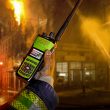Panel: Coexistence of LTE, LMR for quite some time is a safe bet
 I have a friend who is pretty excited right now. When he was in Las Vegas in the early spring, he put some money down on the Milwaukee Brewers to win the World Series at 26-1. Then it was a long shot. Though it’s no sure thing today, with the Brewers in the National League Championship Series, the bet is looking good.
I have a friend who is pretty excited right now. When he was in Las Vegas in the early spring, he put some money down on the Milwaukee Brewers to win the World Series at 26-1. Then it was a long shot. Though it’s no sure thing today, with the Brewers in the National League Championship Series, the bet is looking good.
For most people, it’s not easy to predict the future. There are just too many variables, too many unseen or unanticipated factors, and too many things that are out of one’s control. My friend would tell you that in picking the Brewers he threw a dart at the wall and got lucky.
Recently, however, I interacted with a group of experts who predicted how things are likely to play out concerning the influx of Long-Term Evolution (LTE) technology into the public-safety sector. These experts convened for a webinar that we offered entitled “What keeps you up at night.” For this event, which was sponsored by Cassidian Communications, we had asked our readers that question and based on their responses crafted numerous questions for the panel. One question concerned how to transition to LTE from land-mobile radio.
It likely will be a very long process. According to Andrew Thiessen, requirements and standards lead for Public Safety Communications Research in Boulder, Colo., a unit of the U.S. Department of Commerce, once the LTE-based nationwide public-safety wireless broadband communications system is built, it will exist side by side with the sector’s LMR-based narrowband communications networks for at least a decade. Keep in mind that it likely will take at least a decade to build.
“Given the amount of money that state and local public safety has poured into their LMR systems, we don’t expect that folks are going to be eager to just turn them off overnight,” Thiessen said.
Another factor that will determine how long LTE and LMR systems coexist is that the former is going to have to replicate certain essential capabilities that exist today in the latter — which will take some time to achieve — before LMR systems can be retired. These include talk-around communications, group calls and push-to-talk communications that are similar to what first responders experience today over LMR systems, according to Thiessen.
“Also, will [the LTE system] have the capacity to support the number of users that will be on the system, will it provide the coverage that they expect, and will it be reliable?” Thiessen said.
Wireless industry consultant Andrew Seybold said that it would be a mistake to think that LTE systems will replace LMR systems any time soon. In fact, such thinking could have a detrimental effect on the operation and maintenance of legacy systems, he said.
“There have been a number of elected officials in various cities and counties who have said, ‘I don’t need to invest in my LMR system, I don’t need to keep the LMR system up, because we’re going to go to LTE,’” Seybold said. “That’s a dangerous assumption to make. … There are a lot of positive things going on, but the bottom line is LTE and LMR are going to remain as separate networks for the foreseeable future, and failing to continue to invest and maintain your LMR system is not a smart thing to do.”
Indeed, in some parts of the country, LMR systems will continue to stand alone predicted Ralph Haller, chairman of the National Public Safety Telecommunications Council.
“It’s very likely that in rural areas the buildout of LTE — if it ever comes — is going to be very, very slow, so LTE is simply not going to be an option.” Haller said. “If you’re looking at, for example, trying to have radio coverage during massive wildfires, I just have trouble seeing that LTE is ever going to be able to replace the traditional land-mobile system, in terms of being able to set up a system very quickly with a very limited number of repeater sites, and get that system operational.”
Haller added that, from a propagation standpoint, VHF systems will continue to be essential in forested areas. “With 700 MHz, the trees are like a sponge — it just doesn’t penetrate,” he said. “I think there’s always going to be a need for traditional LMR systems and in some cases LTE simply could never replace the LMR systems are doing today.”
John Powell, NPSTC’s interoperability committee chairman shared Haller’s concerns regarding coverage, and then some.
“You have to remember that a lot of rural LMR systems today have no backhaul — all the connectivity is over the air,” Powell said. “When you look at the coverage differential [between LTE and LMR] some of these rural counties are going to need from two to 10 LTE sites per public-safety employee to provide coverage, including backhaul. That isn’t ever going to happen. It’s just financially unaffordable.”
The panel covered a lot more ground than this and offered a plethora of other terrific insights. The webinar is archived on our website. I urge you to find the time to tune it in. I am certain you will find it time well spent.
What do you think? Tell us in the comment box below.
Related stories:

















